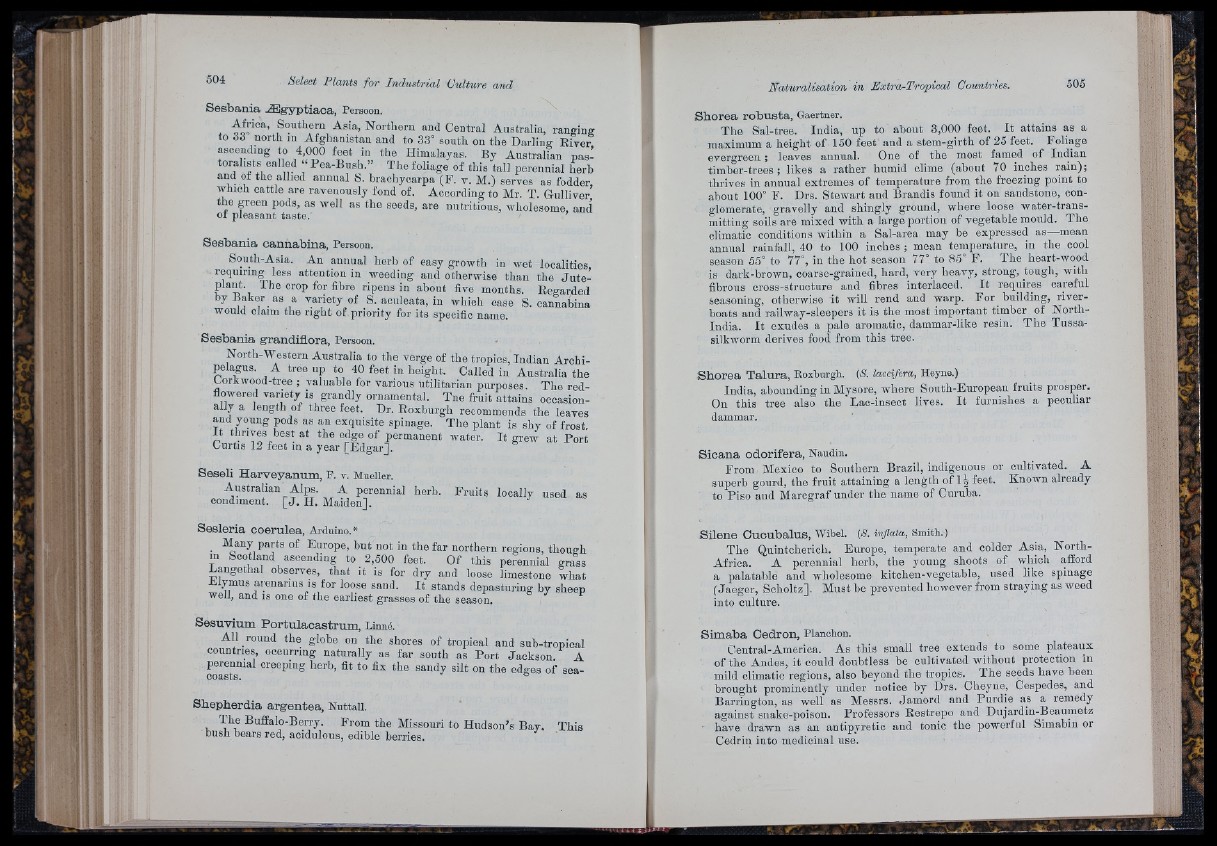
; ífri
i ¥■
I -I;
i
; Y
I;
î l f ' fr
I M î: ' I
. i
■;t! f r 'i ' '1 :l!
¥ - r i
i i i i ' i !
| ;1i '" I-':
i fr ¥■:
1,r1 ^
r ¥ ■fr I
■'Ii ;> ' i r
S e s b a n i a Æ g y p t i a o a , Persoon.
Africa, Southern Asia, iSiorthern and Central Australia, ranging
to dd north in Afghanistan and to 33° south on the Darling River
ascending to 4 000 feet in the Himalayas. By Australian pas!
toralists c a ll^ Pea-Bush.” The foliage of tliis tali perennial l7 rb
and of the allied annnal S. brachycarpa (F. v. M.) serves as fodder,
which cattle are ravenously fond of. According to Mr. T. Gulliver
the green pods, as well as the seeds, are nutritious, wholesome, and
of pleasant taste. ’
S e s b a n i a o a n n a b in a , Persoon.
South-Asia. An annual herb of easy growth in wet localities,
requiring less attention in weeding and otherwise than the Ju te -
plant. The crop for fibre ripens in about five months. Regarded
b y M e r as a variety of S. aculeata, in which case S. cannabina
would claim the right of priority for its specific name.
S e s b a n i a g r a n d if lo r a , Persoon.
North-Western Australia to the verge of the tropics, Indian Arohi-
pelagus. A tree up to 40 feet in height. Called in Australia the
Corkwood-tree ; valuable for various utilitarian purposes. The red-
flowered variety is grandly ornamental. Tne frnit attains occasion-
a llj a length of three feet. Dr. Roxburgh recommends the leaves
and young pods as an e.xquisite spinage. The plant is shy of frost,
i t thrives best at the edge of permanent water. I t grew a t Po rt
Curtis 12 feet in a year [Edgar .
S e seU H a r v e y a n u m , P. v. Mueller.
Australian Alps. A perennial herb,
Fruit.s locally used as
condiment. [ J . H. Maiden].
S e s l e r ia c o e ru le a , Arduino.*
_ Many parts of Europe, but not in the far northern regions, though
in Scotland ascending to 2,500 feet. Of this perennial grass
Langethal observes, that it is for dry and loose imestone what
Elymus arenarius IS for loose sand. I t stands depasturing by sheep
well, and is one of the earliest grasses of the season.
S e s u v d um P o r t u l a c a s t r u m , Linné.
All round the globe on the shores of tropical and sub-tropical
conntries, occurring naturally as far south as Po rt Jackson A
perennial creeping herb, fit to fix the sandy silt on the edges of sea-
coasts.
S h e p h e r d ia a r g e n t e a , Nuttall.
The Bufialo-Berry. Prom the Missouri to Hudson’s Bay. This
busn bears red, acidulous, edible berries.
S h o r e a ro b u s ta , Gaertner.
The Sal-tree. India, up to ahout 3,000 feet. I t attains as a
maximum a height of 150 feet and a stem-girth of 25 feet. Foliage
evergreen ; leaves annual. One of the most famed of Indian
timber-trees; likes a rather humid clime (about 70 inches rain);
thrives in annual extremes of temperature from the freezing point to
abont 100° F. Drs. Stewart and Brandis found it on sandstone, conglomerate,
gravelly and shingly ground, where loose water-transmitting
soils are mixed with a large portion of vegetable mould. The
climatic conditions within a Sal-area may be expressed as—mean
annual rainfall, 40 to 100 inches ; mean temperature, in the cool
season 55° to 77°, in the hot season 77° to 85" F. The heart-wood
is dark-brown, coarse-grained, hard, very heavy, strong, tougli, with
fibrous cross-structure and fibres interlaced. I t requires careful
seasoning, otherwise it will rend and warp. For building, river-
boats and railway-sleepers it is the most important timber of North-
India. I t exudes a pale aromatic, dammar-like resin. The Tussa-
silkworm derives food from this tree.
S h o re a T a lu ra , Roxburgh. (S. laccifera, Heyne.)
India, abounding in Mysore, where South-European fruits prosper.
Ou this tree also the Lac-insect lives. I t furnishes a peculiar
dammar.
S ic a n a o d o rife ra , Naudin.
From Mexico to Southern Brazil, indigenous or cultivated. A
superb gourd, the fruit attaining a length of I 4 feet. Known already
to Piso and Marcgraf under the name of Cnruba.
S ilen e C u o u b a lu s , Wibel. (8. inflóla, Smith.)
The Quiiitcherich. Europe, temperate and colder Asia, North-
Africa. A perennial herb, the young shoots of which afiord
a palatable and wholesome kitchen-vegetable, used like spinage
(Jaeger, Scholtz], Must be prevented however from straying as weed
into culture.
S im a b a Ced ró n , Planchón.
Central-America. As this small tree extends to some p lq e au x
of the Andes, it could doubtless be cultivated without protection in
mild climatic regions, also beyond the tropics. The seeds have been
brought prominently under notice by Drs. Cheyne, Cespedes, and
Barrington, as well as Messrs. Jamord and Purdie as a remedy
against snake-poison. Professors Restrepo and Dujardin-Beaumetz
have drawn as an antipyretic and tonic the powerful Simabin or
Cedrin into medicinal use.